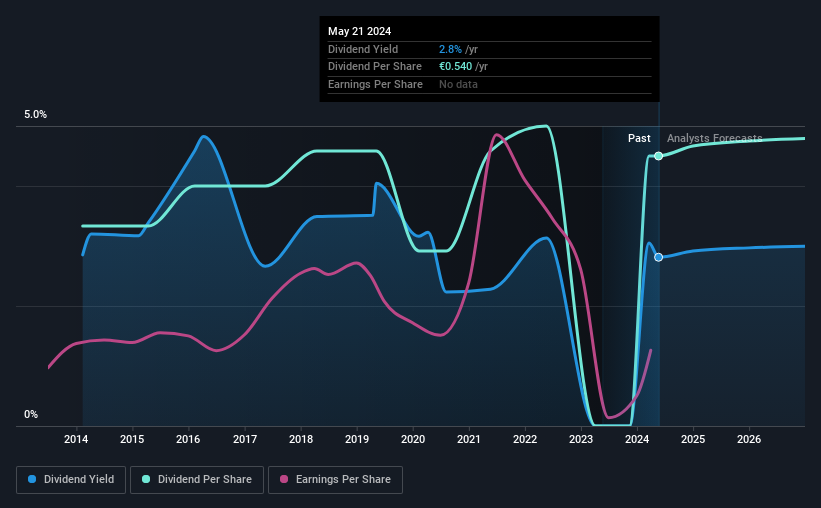Stock Analysis
- Italy
- /
- Consumer Durables
- /
- BIT:SAB
We Wouldn't Be Too Quick To Buy Sabaf S.p.A. (BIT:SAB) Before It Goes Ex-Dividend

Sabaf S.p.A. (BIT:SAB) stock is about to trade ex-dividend in four days. The ex-dividend date occurs one day before the record date which is the day on which shareholders need to be on the company's books in order to receive a dividend. The ex-dividend date is important because any transaction on a stock needs to have been settled before the record date in order to be eligible for a dividend. This means that investors who purchase Sabaf's shares on or after the 27th of May will not receive the dividend, which will be paid on the 29th of May.
The company's next dividend payment will be €0.54 per share, and in the last 12 months, the company paid a total of €0.54 per share. Looking at the last 12 months of distributions, Sabaf has a trailing yield of approximately 2.8% on its current stock price of €19.20. Dividends are a major contributor to investment returns for long term holders, but only if the dividend continues to be paid. That's why we should always check whether the dividend payments appear sustainable, and if the company is growing.
Check out our latest analysis for Sabaf
Dividends are usually paid out of company profits, so if a company pays out more than it earned then its dividend is usually at greater risk of being cut. An unusually high payout ratio of 206% of its profit suggests something is happening other than the usual distribution of profits to shareholders. Yet cash flow is typically more important than profit for assessing dividend sustainability, so we should always check if the company generated enough cash to afford its dividend. What's good is that dividends were well covered by free cash flow, with the company paying out 3.1% of its cash flow last year.
It's good to see that while Sabaf's dividends were not covered by profits, at least they are affordable from a cash perspective. If executives were to continue paying more in dividends than the company reported in profits, we'd view this as a warning sign. Very few companies are able to sustainably pay dividends larger than their reported earnings.
Click here to see the company's payout ratio, plus analyst estimates of its future dividends.

Have Earnings And Dividends Been Growing?
Businesses with shrinking earnings are tricky from a dividend perspective. If earnings fall far enough, the company could be forced to cut its dividend. Sabaf's earnings per share have fallen at approximately 14% a year over the previous five years. Ultimately, when earnings per share decline, the size of the pie from which dividends can be paid, shrinks.
The main way most investors will assess a company's dividend prospects is by checking the historical rate of dividend growth. Sabaf has delivered an average of 3.0% per year annual increase in its dividend, based on the past 10 years of dividend payments. That's intriguing, but the combination of growing dividends despite declining earnings can typically only be achieved by paying out a larger percentage of profits. Sabaf is already paying out a high percentage of its income, so without earnings growth, we're doubtful of whether this dividend will grow much in the future.
The Bottom Line
Has Sabaf got what it takes to maintain its dividend payments? It's never great to see earnings per share declining, especially when a company is paying out 206% of its profit as dividends, which we feel is uncomfortably high. Yet cashflow was much stronger, which makes us wonder if there are some large timing issues in Sabaf's cash flows, or perhaps the company has written down some assets aggressively, reducing its income. With the way things are shaping up from a dividend perspective, we'd be inclined to steer clear of Sabaf.
With that in mind though, if the poor dividend characteristics of Sabaf don't faze you, it's worth being mindful of the risks involved with this business. Case in point: We've spotted 2 warning signs for Sabaf you should be aware of.
If you're in the market for strong dividend payers, we recommend checking our selection of top dividend stocks.
Valuation is complex, but we're helping make it simple.
Find out whether Sabaf is potentially over or undervalued by checking out our comprehensive analysis, which includes fair value estimates, risks and warnings, dividends, insider transactions and financial health.
View the Free AnalysisHave feedback on this article? Concerned about the content? Get in touch with us directly. Alternatively, email editorial-team (at) simplywallst.com.
This article by Simply Wall St is general in nature. We provide commentary based on historical data and analyst forecasts only using an unbiased methodology and our articles are not intended to be financial advice. It does not constitute a recommendation to buy or sell any stock, and does not take account of your objectives, or your financial situation. We aim to bring you long-term focused analysis driven by fundamental data. Note that our analysis may not factor in the latest price-sensitive company announcements or qualitative material. Simply Wall St has no position in any stocks mentioned.
About BIT:SAB
Sabaf
Designs, manufactures, and sells components for household cooking appliances.
Reasonable growth potential with proven track record and pays a dividend.

